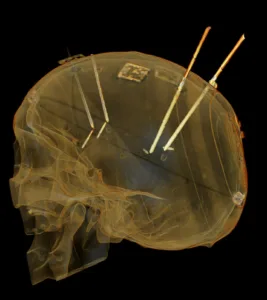The efficacy of Novarad’s VisAR Augmented Reality Guidance system demonstrated an angular error of 1.3° (close to what can be achieved with a robot and below the 2° standard for stereotactic cranial navigation set by the FDA in a recent published article in the peer reviewed journal Neurosurgery for simulated external ventricular drain (EVD) placement.
While EVD is a common neurosurgical procedure, it hasn’t changed much in 100 years. Bedside ICU ventriculostomy is a common procedure that is fraught with error and placement errors occur in up to forty percent of cases using standard freehand technique. To evaluate Novarad’s VisAR system for its potential to improve the accuracy of EVD placement, researchers constructed phantom models: a skull phantom model filled with ballistic gelatin and a phantom model simulating the ventricular structure. In addition, the ability of VisAR flattening the learning curve and improving accuracy of surgeons of various levels of training was studied in a cadaver model.
The measured accuracy was done using VisAR on both phantom and cadaver models. “VisAR provides the precision of a robot, the portability of a stethoscope, and the versatility of human-powered intelligence,” said Dr. Wendell Gibby, Founder and CEO, Novarad. The various experience levels of the participants did not impact their success, illustrating the potential of VisAR accelerating the training of physicians.
“Overall, these accuracy results suggest that a surgeon placing an EVD with AR technology would be capable of millimeter accuracy, which could be especially helpful in cases with small or displaced ventricles,” said Dr. Michael Karsy, Assistant Professor of Neurosurgery, Neurooncology, and Skull Base, University of Utah Health. This result is dramatically better than current standard of care freehand technique.
With under 2-minute setup time, image visible codes for instant registration, and a preoperative planning system allowing trajectory and target design, Novarad’s VisAR system improves workflow while reducing costs compared to other navigation technologies. VisAR, a low-cost navigation technology using an off-the-shelf Microsoft AR headset may revolutionize the delivery of neurosurgical care.

